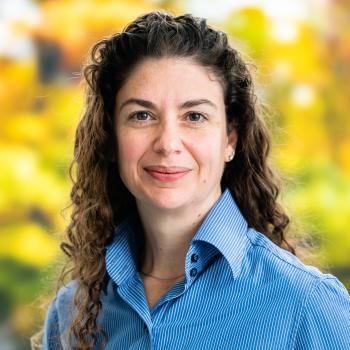Biography
Dr. Pamela Weisenhorn is an Assistant Computational Ecologist in the Biosciences division at Argonne National Laboratory. She is part of the Argonne Wetland Hydrobiogeochemistry Scientific Focus Area (SFA); Systems Biology Knowledgebase (KBase); and Coastal Observations, Mechanisms, and Predictions Across Systems and Scales (COMPASS) groups. Dr. Weisenhorn’s research focuses on the impact of microbial community dynamics on biogeochemical processes, with an emphasis on the metabolism of greenhouse gases in redox dynamic systems. She led the development of a reporting format for microbial amplicon data focused on supporting data reuse for modeling purposes and cross-platform interoperability between KBase and Environmental Systems Science Data Infrastructure for a Virtual Ecosystem (ESS-DIVE) projects. She is also a part of the U.S. Department of Energy’s Environmental System Science Cyberinfrastructure Working Group, the User Facility Sample Interoperability Working Group, and the Society of Wetland Scientists Global Outreach Committee.
Dr. Weisenhorn is a current participant in Argonne’s Launchpad Program, designed to provide motivated early- and mid-career researchers with enhanced training and mentoring for developing multimillion-dollar sponsored research programs. As part of the Launchpad Program, she is developing a new cyberinfrastructure platform focused on incorporating artificial intelligence (AI) approaches to microbial data into the next generation of fully resolved climate models. This modular platform is designed to allow the rapid simulation and exploration of the effects of climate on microbes and the impact of microbes on climate, including field-scale nutrient cycling. By enabling empiricists and field researchers to interact directly and easily with climate models and modelers, the climate community can gain momentum and more rapidly update large-scale models while still benefitting researchers with a smaller scale scientific focus. The modular strategy also enables the breadth of the community of researchers to contribute to the improvement of these critical decision-informing models.
Education:
- Ph.D. in Ecology — University of Minnesota Twin Cities, 2014
- B.S. in Biology with a minor in Coastal Sciences — Louisiana State University, 2003
Select Honors:
- Cohort 6 Selectee of Argonne’s Launchpad Program, 2021
- Postdoctoral Performance Award, Basic Sciences, Honorable Mention, 2017
- Doctoral Dissertation Improvement Grant, National Science Foundation, 2011
Select Publications:
- Damerow, J. E.; Varadharajan, C.; Boye, K.; Brodie, E. L.; Burrus, M.; Chadwick, K. D.; Crystal-Ornelas, R.; Elbashandy, H.; Alves, R. J. E.; Ely, K. S.; Goldman, A. E.; Haberman, T.; Hendrix, V.; Kakalia, Z.; Kemner, K. M.; Kersting, A. B.; Merino, N.; O’Brien, F.; Perzan, Z.; Robles, E.; Sorensen, P.; Stegen, J. C.; Walls, R. L.; Weisenhorn, P.; Zavarin, M.; Agarwal, D. “Sample Identifiers and Metadata to Support Data Management and Reuse in Multidisciplinary Ecosystem Sciences.” Data Science Journal 2021, 20, 1–19.
- Wilhelm, R. C.; Pepe-Ranney, C.; Weisenhorn, P.; Lipton, M.; Buckley, D. “Competitive Exclusion and Metabolic Dependency Structure the Cellulose Economy in Agricultural Soil.” Mbio 2021, 12(1).
- Ward, N. D.; Megonigal, J. P.; Bond-Lamberty, B.; Bailey, V.; Butman, D.; Canuel, E. A.; Diefenderfer, H.; Ganju, N. K.; Goñi, M. A.; Graham, E.; Hopkinson, C. S.; Khangaonkar, T.; Langley, J. A.; McDowell, N. G.; Myers-Pigg, A. N.; Neumann, R. B.; Osburn, C. L.; Price, R. M.; Rowland, J.; Sengupta, A.; Simard, M.; Thornton, P.; Tzortziou, M.; Vargas, R.; Weisenhorn, P. B.; Windham-Myers, L. “Representing the Function and Sensitivity of Coastal Interfaces in Earth System Models.” Nature Communications 2020, 11, 2458.
- Wang, H.*; Cheng, M.; Dsouza, M.; Weisenhorn, P.; Zheng, T.; Gilbert, J. A. “Soil Bacterial Diversity Is Associated with Human Population Density in Urban Greenspaces.” Environmental Science and Technology 2018, 52, 5115–5124.
- Fan, K.*; Weisenhorn, P.; Gilbert, J. A.; Shi, Y.; Bai, Y.; Chu, H. “Soil pH Correlates with the Co-occurrence and Assemblage Process of Potential Diazotrophic Communities in Rhizosphere and Bulk Soils of Wheat Fields.” Soil Biology and Biochemistry 2018, 121, 185–192.
- Thompson, L. R.; Sanders, J. G.; McDonald, D.; Amir, A.; Ladau, J.; Locey, K. J.; Prill, R. J.; Tripathi, A.; Gibbons, S. M.; Ackermann, G.; Navas-Molina, J. A.; Janssen, S.; Kopylova, E.; Vázquez-Baeza, Y.; González, A.; Morton, J. T.; et al.‡ “A Communal Catalogue Reveals Earth’s Multiscale Microbial Diversity.” Nature 2017, 551, 457–463.
- Cardona, C.*†; Weisenhorn, P.†; Henry, C. S.; Gilbert, J. A. “Network-based Metabolic Analysis and Microbial Community Modeling.” Current Opinion in Microbiology 2016, 31, 124–131.
- Henry, C. S.; Bernstein, H.; Weisenhorn, P.; Taylor, R.; Lee, J. Y.; Zucker, J.; Song, H. S. “Microbial Community Metabolic Modeling: A Community Data-driven Network Reconstruction.” Journal of Cellular Physiology 2016, 231, 2339–2345.
- Hobbie, S. E.; Eddy, W. C.; Buyarski, C. R.; Adair, E. C.; Ogdahl, M. L.; Weisenhorn, P. “Response of Decomposing Litter and Its Microbial Community to Multiple Forms of Nitrogen Enrichment.” Ecological Monographs 2012, 82, 389–405.
- Keller, J. K.; Wolf, A. A.; Weisenhorn, P. B.; Drake, B. G.; Megonigal, J. P. “Elevated CO2 Affects Porewater Chemistry in a Brackish Marsh.” Biogeochemistry 2009, 96, 101–117.
- Keller, J. K.; Weisenhorn, P. B.; Megonigal, J. P. “Humic Acids as Electron Acceptors in Wetland Decomposition.” Soil Biology and Biochemistry 2009, 41, 1518–1522.
* denotes student coauthors
† authors contributed equally
‡ contributor to Earth Microbiome Project
